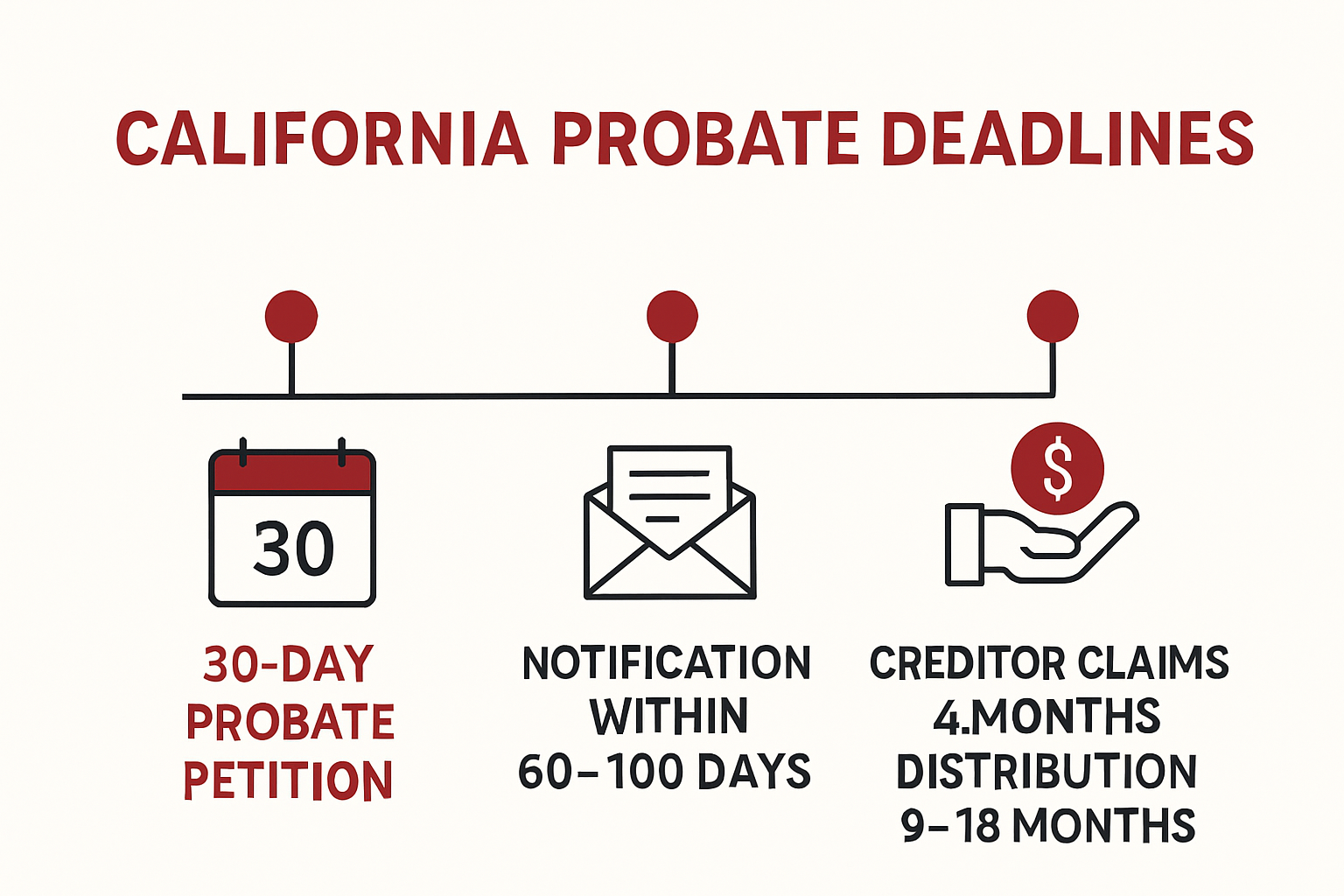
PARENTS & HOMEOWNERS: MY 7-STEP ESTATE PLANNING PROCESS WILL PROTECT YOUR HEIRS
From Creditors, Predators & Bad Choices, And Will Help You Become a (Bigger) Hero to Your Family!



Preparing for Probate Court in California: Essential Steps for 2025
Getting ready for probate court in California is a major task, especially with all the rules changing for 2025. Most people expect endless paperwork and complicated legal steps, but what catches many off guard are the strict deadlines that can make or break an estate. Miss the 30-day window to file the probate petition and you risk costly penalties, delays, and legal headaches that can drag on for months. Knowing where people stumble is the first step to making sure your family’s legacy is protected.
Table of Contents
- Understanding The California Probate Process
- Essential Documents And Deadlines To Prepare
- Protecting Family Wealth And Avoiding Common Mistakes
- Tips For Estate Executors And Property Owners
Quick Summary
| Takeaway | Explanation |
|---|---|
| Understand the probate process | Familiarize yourself with the fundamental steps involved in validating a will and distributing assets. |
| Assemble critical documents promptly | Gather necessary documentation such as the will, death certificate, and inventory of assets without delay. |
| Adhere to filing deadlines | File the probate petition within 30 days to avoid complications and ensure compliance with state regulations. |
| Implement asset protection strategies | Use trusts and clear beneficiary designations to safeguard family wealth during the probate process. |
| Communicate transparently with beneficiaries | Keep heirs informed about estate management to maintain trust and minimize conflicts during probate proceedings. |
Understanding the California Probate Process
Navigating the probate process in California can be a complex and emotionally challenging journey for families dealing with the loss of a loved one. Probate is a legal procedure that validates a deceased person’s will, manages asset distribution, and resolves any outstanding debts or claims against the estate. Understanding this process is crucial for anyone preparing to manage an estate or anticipating potential inheritance.
Key Components of the California Probate Process
The California probate process involves several critical steps that ensure a deceased person’s assets are properly distributed and legal obligations are met. Explore our comprehensive guide to probate details to gain deeper insights into this intricate legal procedure.
According to the California Courts Self-Help Guide, the probate process typically begins when a petition is filed with the local superior court in the county where the deceased person resided. The primary objectives include:
- Asset Identification: Cataloging and appraising all assets owned by the deceased
- Debt Settlement: Paying off any outstanding creditors and tax obligations
- Estate Distribution: Transferring remaining assets to rightful heirs or beneficiaries
Legal Requirements and Court Involvement
California law mandates probate for estates valued over $166,250, unless specific exemptions apply. The Superior Court of California plays a crucial role in overseeing this process, ensuring legal compliance and protecting the interests of all parties involved. Research from the Santa Clara County Courts highlights that the court appoints a personal representative (executor) who manages the estate through several key stages.
The complexity of probate can vary significantly depending on the estate’s size, complexity of assets, and potential disputes among beneficiaries. Larger estates with multiple properties, business interests, or complicated family dynamics often require more extensive legal intervention. This is why many California families seek professional guidance to navigate the intricate legal landscape and minimize potential conflicts.
While the probate process might seem overwhelming, understanding its fundamental components can help families approach this challenging time with greater confidence and clarity. Each step is designed to ensure fair and legal distribution of a loved one’s final assets, providing a structured approach to resolving financial and legal matters during a difficult emotional period.
Essential Documents and Deadlines to Prepare
Successfully navigating California probate requires meticulous preparation and a comprehensive understanding of the required documentation and strict legal timelines. Executors and estate representatives must approach this process with precision to ensure smooth estate administration and prevent potential legal complications.
Critical Probate Documentation
The foundation of a successful probate process lies in assembling the right documents. Learn how to securely store your estate documents to protect your family’s legal interests. According to the California Courts official website, the essential documents include:
- Original Will: The legally valid, signed document detailing the deceased’s final wishes
- Death Certificate: Multiple certified copies from the county registrar
- Petition for Probate: Form DE-111 formally initiating the court process
- Inventory of Assets: Comprehensive list of all estate properties and financial accounts
- Creditor Notification Documents: Formal communications to potential creditors
Here is a summary table outlining the essential probate documents and their purposes to help executors stay organized:
| Document | Purpose |
|---|---|
| Original Will | Outlines the decedent’s final wishes for asset distribution |
| Death Certificate | Provides legal proof of death for court proceedings |
| Petition for Probate (Form DE-111) | Officially starts the probate process in court |
| Inventory of Assets | Documents and values all estate properties and accounts |
| Creditor Notification Documents | Notifies creditors, allowing them to make claims |
Critical Filing Deadlines and Legal Timelines

Cornell Law School’s Legal Information Institute emphasizes the importance of adhering to California’s strict probate timelines. Executors must be aware of several crucial deadlines:
- Filing the petition for probate must occur within 30 days of the decedent’s death
- Notification to heirs and beneficiaries must happen within 15 days of the petition filing
- Creditor claims window is typically four months from the date of estate representative appointment
- Final estate distribution should occur within one year of initiating probate proceedings
To keep track of important probate deadlines, refer to the following timeline table:
| Action/Event | Deadline from Trigger Date |
|---|---|
| File Petition for Probate | Within 30 days of decedent’s death |
| Notification to Heirs/Beneficiaries | Within 15 days of petition filing |
| Open Creditor Claims Window | 4 months from estate representative appointed |
| Distribute Assets/Close Estate | Within 1 year of probate initiation |
Missing these deadlines can result in significant legal complications, potential financial penalties, and extended probate proceedings. Precision and timely action are paramount in navigating California’s complex probate landscape. Professional legal guidance can help executors understand these intricate requirements and ensure full compliance with state regulations, ultimately protecting the estate’s interests and facilitating a smooth transfer of assets to rightful beneficiaries.
Protecting Family Wealth and Avoiding Common Mistakes
Preserving family wealth through California’s probate process requires strategic planning, careful documentation, and proactive legal protection. Families must navigate complex financial landscapes while minimizing potential risks that could erode their hard-earned assets during estate transitions.
Strategic Asset Protection Techniques
Learn how to protect your estate from potential creditors and preserve your family’s financial legacy. According to the California Department of Financial Protection and Innovation, successful wealth preservation involves several critical strategies:
- Trust Establishment: Creating irrevocable trusts to shield assets from potential legal claims
- Comprehensive Beneficiary Designations: Ensuring clear, updated inheritance instructions
- Tax-Efficient Asset Transfer: Minimizing potential tax burdens during estate distribution
- Comprehensive Insurance Coverage: Protecting against unexpected financial vulnerabilities
Avoiding Critical Estate Planning Mistakes
The California Courts Self-Help Guide highlights several common pitfalls that can significantly impact estate value and family financial stability. Families must be vigilant about:
- Failing to regularly update estate planning documents
- Neglecting to consolidate and organize financial records
- Overlooking potential tax implications of asset transfers
- Not designating clear successor trustees or executors
- Underestimating the complexity of asset distribution
Navigating estate preservation requires more than basic documentation. Families must develop a holistic approach that anticipates potential challenges, protects against financial risks, and ensures smooth wealth transfer. Professional legal guidance becomes crucial in identifying potential vulnerabilities and creating robust protection strategies that adapt to changing financial landscapes and family dynamics.
By implementing comprehensive estate planning techniques, families can safeguard their financial legacy, minimize potential conflicts, and provide clear, structured guidance for future generations. The goal extends beyond mere asset transfer it involves creating a sustainable financial framework that protects and empowers family members through strategic, forward-thinking planning.
Tips for Estate Executors and Property Owners
Serving as an estate executor or managing property through California’s probate process demands precision, legal knowledge, and strategic planning. The responsibilities are complex and require a comprehensive understanding of legal obligations, financial management, and ethical decision-making.
Core Responsibilities of Estate Executors
Learn about selecting a trustworthy executor who can navigate the intricate probate landscape. According to the California Courts Estate Representative Guide, executors must systematically manage several critical tasks:
- Asset Inventory: Comprehensively document and appraise all estate assets
- Creditor Notification: Formally communicate with potential creditors and manage claims
- Tax Compliance: File necessary tax returns and settle outstanding tax obligations
- Beneficiary Communication: Maintain transparent communication with all potential inheritors
- Legal Documentation: Prepare and file required probate court documents
Navigating Property Ownership Challenges

The Superior Court of California emphasizes that property owners must take proactive steps to streamline the probate process. Critical considerations include:
- Maintaining accurate property records
- Understanding potential tax implications of property transfers
- Evaluating potential exemptions from full probate proceedings
- Protecting property value during estate administration
- Addressing potential liens or encumbrances
Executors and property owners must recognize that probate is more than a legal procedure it represents a significant financial and emotional responsibility. Successful navigation requires a combination of meticulous attention to detail, emotional intelligence, and strategic planning. Professional legal guidance becomes invaluable in interpreting complex regulations, mitigating potential conflicts, and ensuring a smooth transition of assets.
Ultimately, the goal extends beyond legal compliance. Effective estate management preserves family harmony, protects financial interests, and honors the decedent’s final wishes. By approaching the process with professionalism, empathy, and strategic thinking, executors can transform a potentially challenging experience into a respectful, well-managed transition of legacy and assets.
Frequently Asked Questions
What are the essential steps in the California probate process?
The essential steps include filing a petition for probate, preparing necessary documents, identifying and appraising assets, settling debts, and distributing the remaining estate to beneficiaries.
What documents are required to start probate in California?
Key documents include the original will, death certificate, petition for probate (Form DE-111), inventory of assets, and notification documents for creditors.
What are the filing deadlines for probate in California?
You must file the petition for probate within 30 days of the decedent’s death. Notification to heirs must occur within 15 days of the filing, and creditor claims must be submitted within four months of the representative’s appointment.
How can I protect family wealth during the probate process?
You can protect family wealth by establishing trusts, ensuring clear beneficiary designations, utilizing tax-efficient strategies for asset transfer, and maintaining comprehensive insurance coverage.
Secure Your Path Through California Probate With Experienced Guidance
Are you overwhelmed by changing probate rules, tight 30-day petition deadlines, and the fear of costly court delays? The complex steps you discovered in this article have shown how vital it is to act quickly and avoid mistakes that could put your family’s legacy at risk. Many Californians face confusion gathering important documents or miss key filing deadlines, risking unnecessary fees and family tension. Working with a trusted legal advisor can prevent these common pitfalls and give you peace of mind.

Let the Estate Planning team at the Law Office of Eric Ridley guide you through every essential step—from preparing documents to protecting assets and avoiding probate setbacks. Our commitment is to simplify the process, protect your family’s future, and make sure you never miss a critical deadline. Visit https://ridleylawoffices.com today to schedule a consultation and receive the personalized support you need to secure your estate against tomorrow’s uncertainties.
Recommended
- California Probate Process Explained: 2025 Guide for Families and Homeowners – Law Office of Eric Ridley
- A Step-by-Step Guide to Probate in California – Law Office of Eric Ridley
- Understanding Probate Process in California: 2025 Guide for Families and Homeowners – Law Office of Eric Ridley
- Probate Timeline in California: What Families Need to Know in 2025 – Law Office of Eric Ridley
